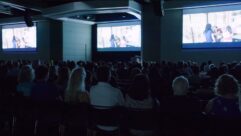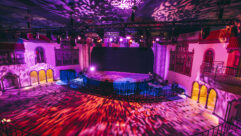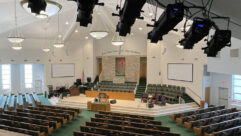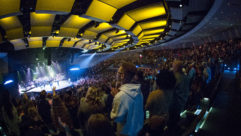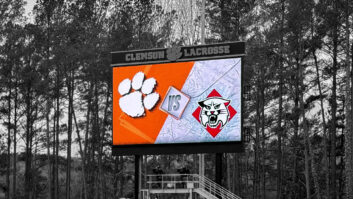Spiritual focus
Jan 1, 1999 12:00 PM,
Jack McLean
Modern times demand modern means. A growing number of religiousorganizations, taking this credo to its fullest, are working with systemsdesigners and contractors in the development of technologically advancedworship facilities. A good example is Fellowship Church, a large house ofworship located on the outskirts of the Dallas/Ft. Worth area in Grapevine,TX. Acoustic Dimensions, Dallas, worked closely with church staff indeveloping video, audio and lighting systems to meet high production valuesand formulated acoustical solutions for the venue.
“What is really important at churches like Fellowship is the accurate andeffective communication of the word of God, to use a theological term, inwhatever form that takes, be it spoken, poetic, dramatic or musical,” saidCraig Janssen of Acoustic Dimensions. “This setting requires the highestdegree of musical and artistic preparation and the highest degree oftechnology.”
In essence, Fellowship Church is a faction of Evangelical orthodoxyproviding worship in a contemporary format. Sometimes referred to asseeker-targeted, churches of this genre try to reach people who, forvarious reasons, have lost touch with the idea of church or have notpreviously been exposed. Whatever the case, the goal is to connect withservices designed and presented to accomplish just that.
Willow Creek Community Church, outside of Chicago, helped set the pace forthis genre of worship program more than a decade ago. It recognized thepower that technology could have in helping to meet these goals. As aresult, it is recognized as the top seeker-targeted ministry in the UnitedStates with a full-time technical staff of 10 and a total production staffnumbering close to 20.
“Perhaps it is best to describe the worship services as theologicaltheater,” Janssen said. “Everything is presentational in nature, so it’stheatre with spiritual focus.”
The experiences presented by churches like Fellowship and Willow Creek arethoroughly prepared, but they are also quite creative and artistic.Services include multiple songs, perhaps multiple dramas and several videopresentations. These services necessitate sophisticated equipment supportedby a qualified in-house professional technical staff.
“The method of conveying the message is different with the focus oneffective communication in the theatrical environment,” Janssen said.”Broadway spends extraordinary sums of money on systems technology for thesame reason. These types of churches offer a similar experience.”
Acoustic Dimensions has enjoyed success in supplying systems designs forthe church market, a success that goes beyond knowing where to pointloudspeakers. Its prosperity is a direct result of understanding what achurch wants to present and achieve. The overwhelming majority ofseeker-targeted organizations are new. Simply, the transition from atraditional structure to a more dynamic one is usually too tough a path tonavigate for political and logistical reasons. The concession for thesystem developer working with fledgling groups is often a limitation ofresources, particularly in relation to the group’s aggressive goals.
“It has everything to do with understanding a church’s program and thatchurch’s ultimate goal,” Janssen said. “We make it absolutely certain thatwe hear where the client is heading. Generally, the first priority ismaking the main auditorium the focus of most of its resources. The goal isto develop systems that are realistic from a budgetary standpoint whilemeeting expectations as fully as possible.”
Nearly three years ago, Acoustic Dimensions began discussions withFellowship board members regarding what was planned as a new, albeitsomewhat interim facility. In particular, tight budgets limited thecapability of the various production systems within the open, flat-sidedwarehouse-style sanctuary, which seats more than 4,000. The sanctuary is arectangular box, about 2009×1009 (61 m x 30 m) with a large stage centeredin one of the long sides. A deep balcony spans the entire back of the room,andceiling height is consistently more than 50 feet (15 m) above the mainfloor. At about the halfway point in the initial design process, fundingincreased substantially; audio and video systems budgets roughly doubled.Preliminary designs were totally scrapped and redone.
“Everything changed,” Janssen said. “We performed major upgrades of thevideo and audio systems to put them more in line with what the churchneeded, so it was fortunate that the budget situation was addressed. Inaddition, a full production facility with recording and editing space wasadded.”
A large team contributed its talents to designing and implementing thevariety of systems and technologies at Fellowship Church. Further, DaleAlexan-der and Angie Janssen of Acoustic Dimensions served as projectengineers, coordinating and guiding of complex installation issues andschedules.
Large imagesA large control room on an upper level outside the main sanctuary is thenerve center of the video and recording systems, and it also hosts racks ofmain audio system equipment. The video system, developed with independentdesigner Ray Terrill and Fellowship technical director Curtis Cruson andinstalled by Ancha Electronics, features IMAG projection onto 129×169 (3.7m x 4.9 m). Stewart screens are flown at each side of the main platform atthe front of the sanctuary. Video screen size and location are critical,particularly in a large space. Structural conflicts and stage requirementsmade this difficult.
“Everything starts with the screens and moves backward,” Alexander said.”Fortunately, we were able to use big screens here, and sightlines aregood.”
Images are supplied by Barco 8200 projectors at 2,500 ANSI lumens.Meanwhile, video monitors located in the lobby and the cry room alsoreceive a feed, but it often differs from what appears on the sanctuaryscreens.
“What is played on the big screens isn’t necessarily what you want to seeon the outside monitors. When inside the sanctuary, you also see what’shappening on stage. This makes wide-angle views unnecessary,” said StuartReynolds of Acoustic Dimensions, who contributed to the video systemimplementation. “There is both a production switcher and a matrix routingswitcher, so they can offer a different, more appropriate program to themonitors. This lends itself to providing television broadcast capabilityquickly.”
Three Sony D30WS cameras are positioned in the sanctuary on mobile tripods.About 30 feet (9 m) of extra cable with each camera provides the directorand camera operators a liberty in choosing shot position. All camerapositions are linked to the control room via a ClearCom intercom routedthrough the camera and CCU. Conduit and cabling has also been run toseveral different locations on both the balcony and main floor as well ason the front platform for system expansion for special events needingmultiple camera reinforcement.
“A top priority was keeping cameras and other technology from intrudinginto the services,” Reynolds said. “Cameras, lights and operator positionswere carefully positioned so as not to detract from the program.”
The system’s backbone is serial digital, a decision made partly because ofthe church’s stated preference for Grass Valley digital switchers.Currently, all inputs are analog. Timing is done at both switching subsetsof the system, the digital matrix router and the digital productionswitcher. The resulting signals are then converted back to analog andsupply the video projectors and various recording devices. The primary usefor this system is IMAG production with room for expansion.
“At some point, the church will graduate to the use of a production-levelcharacter generator and digital video effects subsystem,” Reynolds said.”For ease of use and staff comfort level, however, PowerPoint and thetransitions provided by the digital switcher make the most sense right now.”
The dual switching/routing configuration and the transition from analog todigital are simplified by Leitch D/A converters. An analog signal issupplied to Sony Betacam SP decks for archival recording and editing and toPanasonic S-VHS decks for immediate pastoral production meeting usage. Theprocess is the reverse for production playback from Sony Betacam SP decksand the church’s Media 100 nonlinear editing system. An audio-for-videoproduction suite behind the main video control area also doubles for minoraudio-only recording. The suite’s dedicated console is fed via transformersplit from the house mics and a small adjacent rehearsal and recordingstudio. All video production sources are routed to this audio console forpre-mix before the audio to follow the live production video. This setupallows an independent audio mix for video that can be routed back to thedigital switching matrix for breakaway video recording, creation of editedmaster tapes or future broadcast.
“The objective is to use video to support what’s happening on theplatform,” Craig Janssen said. “This can mean putting words on the screenfor singing or scriptures, posting announcements or doing IMAG. The systemcan also serve as a separate supplement where they play video drams,vignettes or other elements that cannot otherwise be put on the stage.”
Acoustical aspectsIt is important to note that the Fellowship Church building, while new, isplanned only as an interim worship facility. Plans call for construction ofa 10,000-seat facility adjacent to the current building, which will then beconverted into a gymnasium. Acoustically, the sanctuary’s large,rectangular-box structure created problems. Of particular concern wereperfectly parallel side walls. Ultimately, the walls were covered withacoustical panels. All seats are padded and fairly absorbent. The otherinteresting challenge involved the location, just a few miles south of DFWInternational Airport and right below a major flight path. Grapevine cityordinances require all facilities in this region to conform to fairlystrict noise abatement requirements; noise cannot exceed NC35.
“The ordinances state that not only must a building be protected fromexternal noise, but it must also adhere to fairly strict internal noiseguidelines,” said David Kahn of Acoustic Dimensions, leader of theproject’s acoustical design phase.
This resulted in rather extensive treatments, including a composite sealstructure for the roof. The drop ceiling has a double layer of chipboardwith all air ducts encased in chipboard. All exterior doors are double; nodoor leads straight into the sanctuary. All doors are tightly sealed aswell.
“As it turns out, we did not mind making the room NC35,” said Kahn. “Ourgoal was actually NC25, but budget restrictions necessitated our raisingthat to NC30, a bit noisier than we liked but still good.”
During the design process, the church staff was adamant that a sense ofcommunity was quite important within the sanctuary. Program has become sopresentational in nature, however, that singing and other interaction isless central to services than previously thought. This is not an unusualfacet when developing systems for dynamic worship organizations.
“During the design process, not only do different staff members come onboard because the church is growing, but the focus of the ministry may alsochange,” Kahn said. “When dealing with a church that has doubled inmembership over a two-year period, a lot of things change. You try toextrapolate where things are heading as you go, build in as muchflexibility as possible, and be as close to the mark as you can when thedoors open.”
Diverse audioProduction requirements virtually dictated a dynamic stereo audio system,one capable of supplying exceptional spoken-word intelligibility whileaccurately reinforcing a wide variety of music. Once funding becameavailable, this design was upgraded to a left-center-right (LCR) mainsystem with extensive cross-matrixing that extends to the delayloudspeakers. Although an LCR approach can push cost up as much as 30%,this project warranted the extra resources. A basic rock music presentationcan be adequately accommodated by a left-right system, but a center clusterbest accommodates speech. As a result, all three main clusters-flown morethan 20 feet (6 m) apart in a scrimmed alcove above the stageproscenium-are essentially identical.
Different parts of a church program, unlike a concert, require variouslevels of clarity and believability, and there is a level of intimacy froma center cluster that is simply more real and believable for thisapplication. Take a singer combined with a six-piece string section and alight rhythm section, however, and the picture is different. It shouldinstead be spread among all three clusters.
“A well-designed LCR system gives you the best of all worlds,” CraigJanssen said. “It then doesn’t matter what the program is. For example, adrama can be given a sweet sound, and maybe it’s based stage left, and youcan run most of the program through the left cluster, which can be a greateffect.”
A row of three-way full-range loudspeakers mounted in a line following thefront edge of the balcony supplement the main clusters. Coverage to theshadowed areas beneath the balcony is provided by compact two-wayloudspeakers mounted to the underside of the balcony, well out ofsightlines. The extensive cross-matrixing of all of these loudspeakers isachieved with the Peavey MediaMatrix MM950 mainframe. The cross-matrixingensures precise coordination between the main clusters and delays onarrival times, taking all possibilities into consideration. All delayloudspeakers receive a left-center-right feed, with more than 60 individualdelay channels painstakingly established and customized on the MM950 tokeep it all in sync. In addition, the MM950 supplies all other digitalsignal processing parameters established as presets within the unit andlikely not to be altered. The house engineer, Matt Wheeler, can selectpresets and monitor performance at the house mix position via a monitor andkeyboard linked by a Cybex extender to the MM950 mainframe located in aremote backstage room with the system’s Crown Macro-Tech power amps.
A Soundcraft SR5 console resides at the mix position established in thefront/center of the balcony. A true left-center-right console, it includes40 mono channels, eight stereo channels, along with 12 aux sends, 10 VCAsand eight subgroups.
“We’re pleased with the SR5 as is the client,” Janssen said. “We have justthree primary feeds from the console and can feed into the DSP with panningall level matched.”
Outboard signal processing gear at the mix position, including Ashlyfive-band parametric and 1/3-octave EQs as well as Lexicon, Sony and Yamahaeffects units. Even further flexibility is provided in the form of a512-point patchbay. Cassette and CD players are from Denon with a PanasonicDAT on hand as well.
“Everything that goes into the console is fed to the patchbay, includingevery piece of support gear,” Janssen said. “We have tie lines into theback of house in many locations, and we can also patch directly into theDSP system.”
The sound system was installed by Electro Acoustics, Ft. Worth, TX, a firmnoted for its work on a diverse range of projects throughout the region.Janssen noted that it staff performed well in properly implementing thecomplex system.
A fine lineThe main clusters use Eastern Acoustic Works (EAW) loudspeakers. ThreeMH662 mid/high loudspeakers in tightly packed arrays top each clusterproviding long-throw. Arrays of two mid/high MH660s are positioned below,firing downward at a fairly steep angle and covering the nearer main floorseats. Individual horns with compression drivers attached to the bottom ofthe MH660s cover essentially the same area, thereby enhancing imaging as itrelates to the stage.
“EAW can develop loudspeakers that bridge the fine line of musical warmthand naturalness and vocal clarity,” Janssen said. “There may be otherproducts that do either facet a bit better, but not in combination of thetwo.”
Tight control of low-frequency performance is attained through Janssen’spatented Tuned Dipolar Array (TDA) concepts, which is incorporated in thedual EAW TD415 low-frequency loudspeakers in each cluster. TDA wasdeveloped to overcome off-axis, low-frequency projection and to minimizeundesirable lobing effects from multiple low-frequency drivers. TDA systemsuse of two pairs of drivers-each spaced so that there is optimalcancellation at a given (tuned) frequency-and exhibit pattern control of atleast 10 dB down at 90 degrees off axis, 100 Hz to 400 Hz. Low-frequencyenergy is kept off the stage while performance is smooth and consistent.
Subwoofers would not fit beneath the stage, Acoustic Dimensions’ preferredlocation. Instead, the four Bag End Quartz subwoofers, each with four 18inch (457 mm) woofers, are flown to the right of the center cluster. Wingsmounted on each side of this cluster add an additional half space ofloading. The TDAs are solid at 50 Hz and extend down to 40 Hz prettycomfortably. With the subs, low end is extended to 20 Hz.
Six EAW ASV7652 full-range loudspeakers bolster coverage to the balcony,flown in a line about 70 feet (21 m) into the house. They enhance thecoverage of the main clusters, particularly on the lower end.
“We used a trick called acoustic mirror imaging with these loudspeakers,”Janssen said. “The ASV7652s were placed and aimed to make maximum use ofthe rigid horizontal surface of the ceiling. As a result, a phantom linearray was created, extending pattern control down a full octave all the wayto the back of the room.”
Six EAW UB22 compact loudspeakers were built into the front of the stagewith their own processing parameters and able to be cross-matrixed.Usually, they work precisely in tandem with the horns flown from the bottomof the main clusters. Additionally, 28 EAW UB82 compact loudspeakers aremounted in pairs beneath the balcony with each pair individuallyaddressable through processing.
A healthy stage monitoring system features both Shure in-ear monitors andEAW SM155 compact wedges for select vocal monitoring. A Mackie SR40 8console anchors the backstage mix position, supplying six EIM and two wedgemixes. Outboard gear includes Ashly 1/3-octave EQs, Behringer compressorsand an Alesis Quadraverb.
Ongoing lightingThe lighting design featured consultation from John Weygandt, stafflighting director at Willow Creek, who worked with Acoustic Dimensions anda church lighting staff appointed as the project evolved. Budgetlimitations dictated only a single lighting catwalk; its location wasselected as a compromise to provide lighting angles acceptable both fortheatre and television, with more priority placed on theatre.
An Electronic Theatre Controls (ETC) Expression lighting console offers 250channels, located adjacent to the house sound mix position. Lightingfixtures on the catwalk are predominantly ETC Source Four with 8 inchfresnel and PAR 64 fixtures mixed in. With all walls and the ceilingthroughout the sanctuary painted black, house lighting proved a challenge,particularly on the main floor. This is currently being addressed. Threeracks of Sensor dimmers supply up to 512 channels and potentially 46,800 Wwith only about 20% of that capability used at the outset.
“Budget limitations applied only to the catwalk structures, not to thelighting system,” Janssen said. “It would have been better to have anothercatwalk in the room, but this just wasn’t feasible.”
Increasing demandFellowship Church represents an ongoing trend toward effective use ofleading technology in the larger house of worship market. It is also safeto assume that this trend will extend into smaller, more traditionalchurches as they recognize the benefits new developments can have inenhancing communication of their messages.
“Certainly it’s not likely that the mass of the church market will beimplementing sound and video systems to the extent of groups likeFellowship Church,” Janssen said. “At the same time, the understanding ofthe impact of technology is becoming more widespread, while the ability andskill of systems integrators to assemble more sophisticated systems withina set budget is certainly much more common. This will lead to an increaseddemand throughout the church market for higher production values.”


